Year 2016 summary
During 2016 a total of 83 queries have been managed in SESC. Of these, 11 were purely telematic and the remaining 72 requests corresponded to laboratory analysis of samples.
During 2016, 29 entries have been published in this blog in Catalan, Spanish and English language. Thirteen of them were diagnostic challenges. A total of 39.769 visits have been recorded.
Below is a summary of the data from this year. Once again, we take this opportunity to acknowledge the cooperation and efforts of pathologists and animal health experts in IRTA-CReSA, the SDPV, and the UAB Faculty of Veterinary Medicine, as well as that of the Public Health Agency of Catalonia (ASPCAT) staff, especially the veterinary meat inspectors whose contributions make the success of this page possible.
We wish you a cool 2017 and do not hesitate to leave us your comments and suggestions at the end of this post!
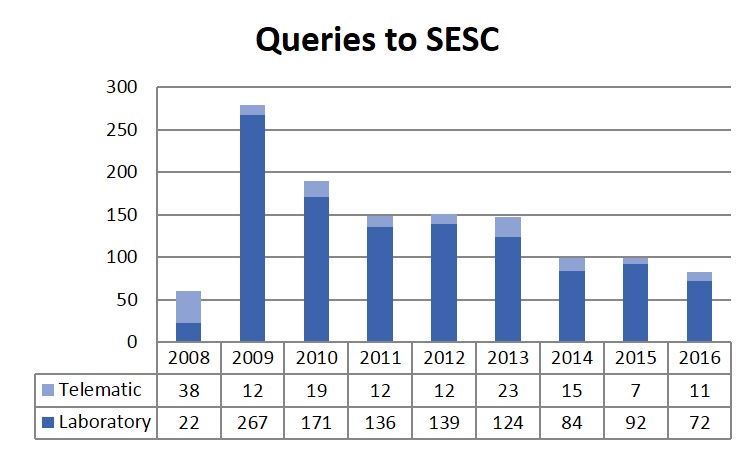
In 2016, the number of inquiries received has decreased by 16% over the previous year.
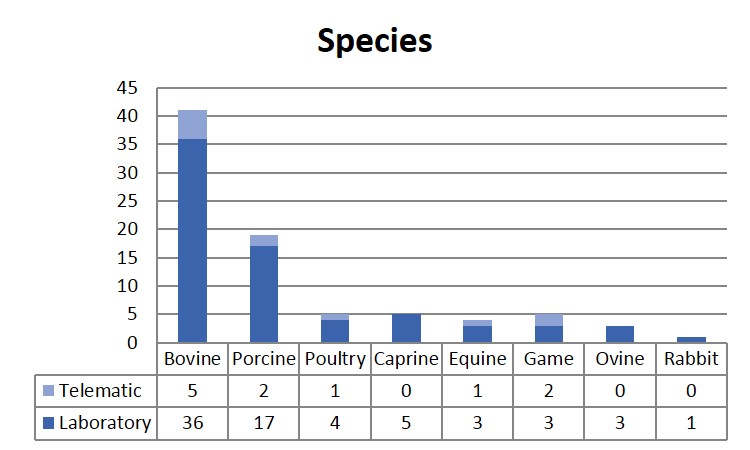
As usual cattle is the species that most queries generates. Among other reasons, because samples are submitted to rule out suspect cases of zoonotic diseases such as bovine cysticercosis or tuberculosis.
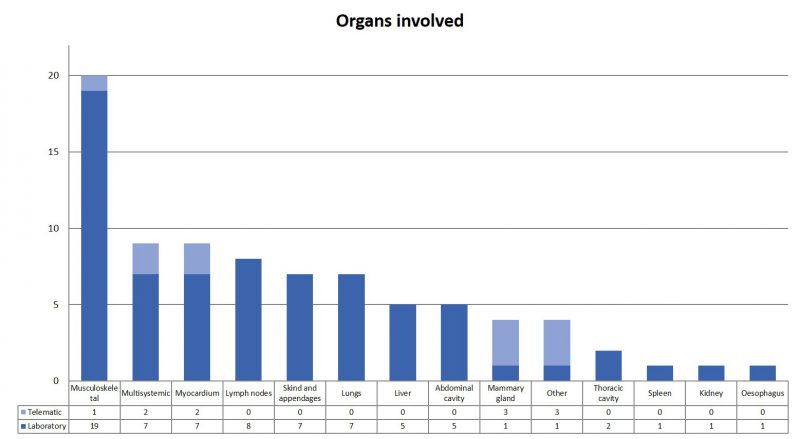
Distribution by organs of the inquires received. Most muscle/myocardial samples were submitted to rule out cysticercosis and lymph nodes/thoracic cavity to rule out Tuberculosis.
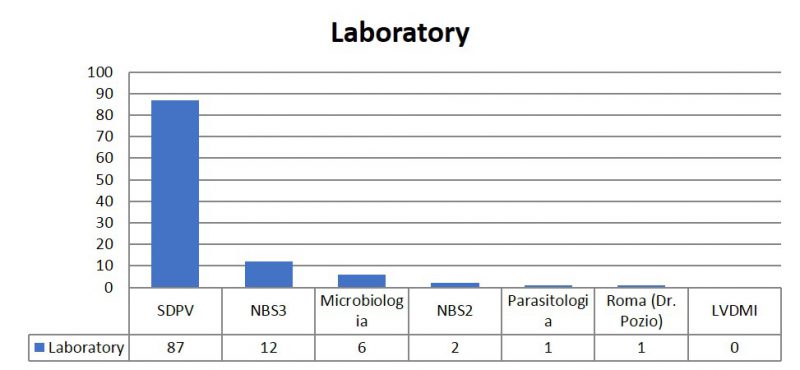
Distribution of the samples according to the diagnostic service. SDPV: veterinary pathology diagnostic service. BSL3 biocontainment level unit 3 in CReSA. NBS2 CReSA conventional laboratories. The Veterinary bacteriology and mycology service (SVBM) and the parasitology laboratories are from the veterinary school at UAB. A sample was sent to the European reference laboratory for Trichinella in Rome, Italy (Dr. Pozio). A single query can generate different samples in the same service or different services.
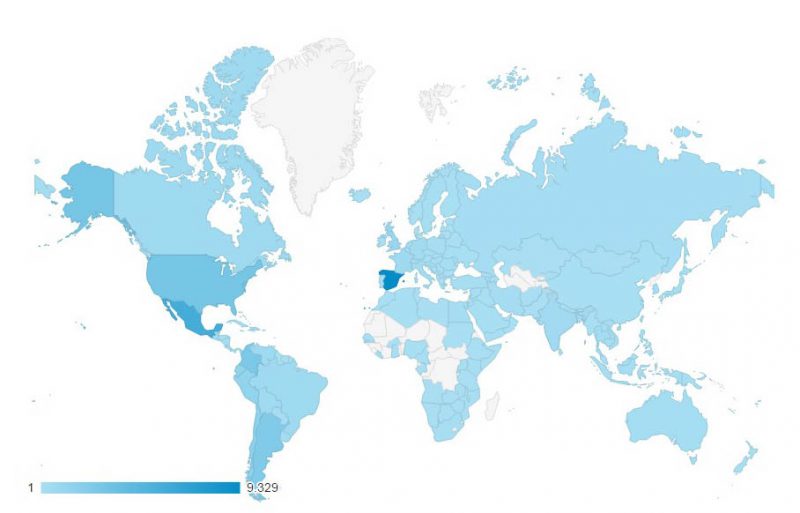
The top ten countries that visit the blog include: Spain 9329 (23.46%), Mexico 5.649 (14,20%), United States 2864 (7,20%), Colombia 2599 (6,54%), Argentina 2.302 (5,79%), Chile 1.568 (3,94%), Perú 1377 (3,46%), Ecuador 1.291 (3,25%), United Kingdom 878 (2,21%) and Brazil 600 (1, 51%).
| Table 1: SUSPECTED CASES and DIAGNOSES | |||
| SUSPECTED CASES | Nº of inquiries | % suspect confirmation | DIAGNOSES |
| Tuberculosis* | 19 | 47% (9/19) | Tuberculosis (9)**
Pyogranulomatuos bacterial Lymphadenitis (4) Fungal lymphadenitis (3) Lung adenocarcinoma (1) Prescapular pseudotuberculosis (1) Chronic proliferative peritonitis (1) |
| Cysticercosis | 21 | 48% (10/21) | Bovine Cysticercosis (10)
Eosinophylic myositis (8) Degenerative myopathy (1) Focal accumulation of adipose tissue (1) Focal accumulation of lymphoid tissue (1) |
* This classification includes submitted samples in which, despite the fact that the inspector did not report a TB suspicion, the lesion was compatible macroscopically with TB. Note that, in all three cases of fungal granulomas, the inspectors who referred them already suspected this etiology. ** The diagnoses of TB correspond to cattle (n = 4), goats (n = 3) and wild boar (n = 2).
In relation to the previous year there has been a reduction in the submitted number of suspected tuberculosis lesions (from 36 in 2015 down to 19). The percentage of lesions confirmed as TB remains constan over the years around a 50%, underlining the importance of not lowering the guard and analyzing all granulomas compatible with Tuberculosis to reinforce the surveillance program of this zoonosis.
| Table 2: Summary od inquiries and diagnoses | ||
| Category | N | DIAGNOSES |
| Infectious | 14 | TBC (9)
Marek's disease (1) Prescapular pseudotuberculosis (1) Suppurative Lymphadenitis (Trueperella pyogenes) (1) Suppurative hepatitis and fibrosis (Trueperella pyogenes) (1) Erysipelas (1) |
| Neoplasia | 10 | Lymphoid Neoplasia (3)
Lung adenocarcinoma (1) Cortico-adrenal Carcinoma (1) Hemangioma (1) B cell leukemia (1) Ovarian adenocarcinoma (1) |
| Parasites | 16 | Bovine cysticercosis (10)
Toxocara cati (2) Trichinella (1) Cysticercus pisiformis (1) Cysticercus ovis + Cysticercus tenuicollis (1) Mange (1) |
| Inflammatory | 26 | Eosinophylic myositis (8)
Unspecific dermatitis (4) Suppurative granulomatous bacterial lymphadenitis (4) Mastitis (2) Yellow fat disease (2) Chronic proliferative peritonitis (1) Fat Necrosis (1) Chronic granulomatous pneumonia (1) Hepatic scirrosis (1) Insect bite dermatitis (1) |
| Fungal | 4 | Fungal lymphadenitis (3) |
| Others | 9 | Degenerative myopathy (1)
Focal accumulation of adipose tissue (1) Focal accumulation of lymphoid tissue (1) Renal fibrosis and amyloidosis (1) Hematoma (1) Melanosis maculosa (1) Chronic hepatopathy (1) |
| Non-diagnostic inquiries | 3 | Enquiry about TB lesions in horses (1)
Enquiry about mastitis in lactating sows (1) Enquiry about serological diagnosis of cysticercosis (1) |

